Abstract
The ability of bacterial cultures to degrade diethanolamine under anoxic conditions with nitrate as an electron acceptor was investigated. A mixed culture capable of anaerobic degradation of diethanolamine was obtained from river sediments by enrichment culture. From this a single bacterial strain was isolated which could use diethanolamine, monoethanolamine, triethanolamine and N-methyl diethanolamine as its sole carbon and energy sources either aerobically or anaerobically. Growth on diethanolamine was faster in the absence of oxygen. The accumulation of possible metabolites in the culture medium was determined as was the ability to grow on certain putative intermediates in the degradation of diethanolamine. A possible pathway for the degradation of ethanolamines by this organism is suggested.
Similar content being viewed by others
References
Anon (1983) Final report on the safety of triethanolamine, diethanolamine, and monoethanolamine. J. Am. Coll. of Toxicol: 2: 183–235
Bradbeer C (1965a) The clostridial fermentation of choline and ethanolamine I. J. Biol. Chem. 240: 4669–4674
Bradbeer C (1965b) The clostridial fermentation of choline and ethanolamine II. J. Biol. Chem. 240: 4675–4681
Calmels S, Ohshima H, Crespi M, Leclerc H, Cattoen C & Bartsch H (1987) N-Nitrosamine formation by microorganisms isolated from human gastric juice and urine; biochemical studies on bacterially-catalysed nitrosation. In: Bartsch H, O'Neill IK & Shulte-Hermann R (Eds) Relevance of N-Nitroso Compounds to Human Cancer: Exposures and Mechanisms. (IARC Scientific Publication 84: pp 391–395). International Agency for Research on Cancer, Lyon
Chang GW & Chang JT (1975) Evidence for the B12-dependent enzyme ethanolamine deaminase in Salmonella. Nature 254: 150–151
Cripps RE & Noble AS (1973) The metabolism of nitrilotriacetate by a pseudomonad. Biochem. J. 136: 1059–1068
Edens MR & Lochary JF (1991) Alkanolamines. In: Kirk-Othmer Encyclopedia of Chemical Technology, Vol 2, 4th edn. (pp1–26). Wiley Interscience, New York
Egli T & Weilenmann H-U (1986) Biodegradation of nitrilotriacetic acid (NTA) in the absence of oxygen. Experimentia 42: 1061–1062
Emtiazi G & Knapp JS (1994) The biodegradation of piperazine and structurally-related linear and cyclic amines. Biodegradation 5: 83–92
Enfors S-O & Molin N (1973a) Biodegradation of nitrilotriacete (NTA) by bacteria I. Isolation of bacteria able to grow anaerobically with NTA as sole carbon source. Water Res. 7: 881–888
(1973b) Biodegradation of nitrilotriacete (NTA) by bacteria II. Cultivation of an NTA-degradaing bacterium anaerobic medium. Water Res. 7: 889–893
Frings J, Wondrak C & Schink B (1994) Fermentative degradation of triethanolamine by a homoacetogenic bacterium. Arch. Microbiol. 162: 103–107
Gannon JE, Adams MC & Bennet EO (1978) Microbial degradation of diethanolamine and related compounds. Microbios 23: 7–18
Jenkins D & Medsker LL (1964) Brucine method for the determination of nitrate in ocean, estuary and fresh waters. Analytical Chemistry. 36: 610–612
Jenal-Wanner U & Egli T (1993) Anaerobic degradation of nitrilotriacetate (NTA) in a denitrifying bacterium: purification and characterisation of the NTA dehydrogenase-nitrate reductase enzyme complex. Appl. Environ. Microbiol. 59: 3350–3359
Jones A & Turner JM (1971) Microbial metabolism of amino alcohols via aldehydes. J. Gen Microbiol. 67: 379–381
Jones A & Turner JM (1973) Microbial metabolism of amino alcohols. Biochem J. 134: 167–182
Kornberg HL (1966) Anaplerotic sequences and their role in metabolism. Essays in Biochemistry 2: 1–31
Large PJ (1971) The oxidative cleavage of alkyl-nitrogen bonds in microorganisms. Xenobiotica 1: 457–467
Leach SA, Cook AR, Challis BC, Hill MJ & Thompson MH (1987) Bacterially mediated N-nitrosation reactions and endogenous formation of N-nitroso compounds. In: Bartsch H, O'Neill IK & Shulte-Hermann R (Eds) Relevance of N-Nitroso Compounds to Human Cancer: Exposures and Mechanisms. (IARC Scientific Publication 84: pp 396–399). International Agency for Research on Cancer, Lyon
Lloyd D, Boddy L & Davies KJP (1987) Persistence of bacterial denitrification capacity under aerobic conditions: the rule rather than the exception. FEMS Microbiol Letts. 45: 185–190
Patureau D, Davidson J, Bernet N & Moletta R (1994) Denitrification under various aeration conditions in Comamonas sp., strain SGLY12. FEMS Microbiology Ecology 14: 71–78
Robertson LA & Kuenen JG (1984) Aerobic denitrification — old wine in new bottles. Antonie van Leeuwenhoek 50: 525–544
Rothkopf GS & Bartha R (1984) Structure-biodegradability correlations among xenobiotic industrial amines. JAOCS 61: 977–980
Scarlett FA & Turner JM (1976) Microbial metabolism of amino alcohols. Ethanolamine catabolism mediated by a coenzyme B12-dependent ethanolamine ammonia-lyase in Escherichia coli and Klebsiella aerogenes. J. Gen Microbiol. 95: 173–176
Smith NA, Smith P & Woodruff CA (1992) The role of Bacillus sp. in N-nitrosamine formation during wort production. J. of the Inst. of Brewing 98: 409–414
Swain A, Waterhouse KV, Venablese WA, Callely AG & Lowe SE (1991) Biochemical studies of morpholine catabolism by an environmental mycobacterium. Appl. Microbiol. Biotechnol. 35: 110–114
Uetz T, Schneider R, Snozzi M & Egli T (1992) Purification and characterisation of a two-component monooxygenase that hydroxylates nitrilotriacetate from “Chelatobacter” strain ATCC29600. J. Bacteriol. 174: 1179–1188
Wanner U, Kemmler J, Weilenmann H-U, Egli T, El-Banna T & Auling G (1990) Isolation and growth of a bacterium able to degrade nitrilotriacetic acid under denitrifying conditions. Biodegradation 1: 31–41
Williams GR & Callely AG (1982) The biodegradation of diethanolamine and triethanolamine by a yellow gram-negative rod. J. Gen Microbiol. 128: 1203–1209
Author information
Authors and Affiliations
Rights and permissions
About this article
Cite this article
Knapp, J.S., Jenkey, N.D. & Townsley, C.C. The anaerobic biodegradation of diethanolamine by a nitrate reducing bacterium. Biodegradation 7, 183–189 (1996). https://doi.org/10.1007/BF00058178
Accepted:
Issue Date:
DOI: https://doi.org/10.1007/BF00058178




